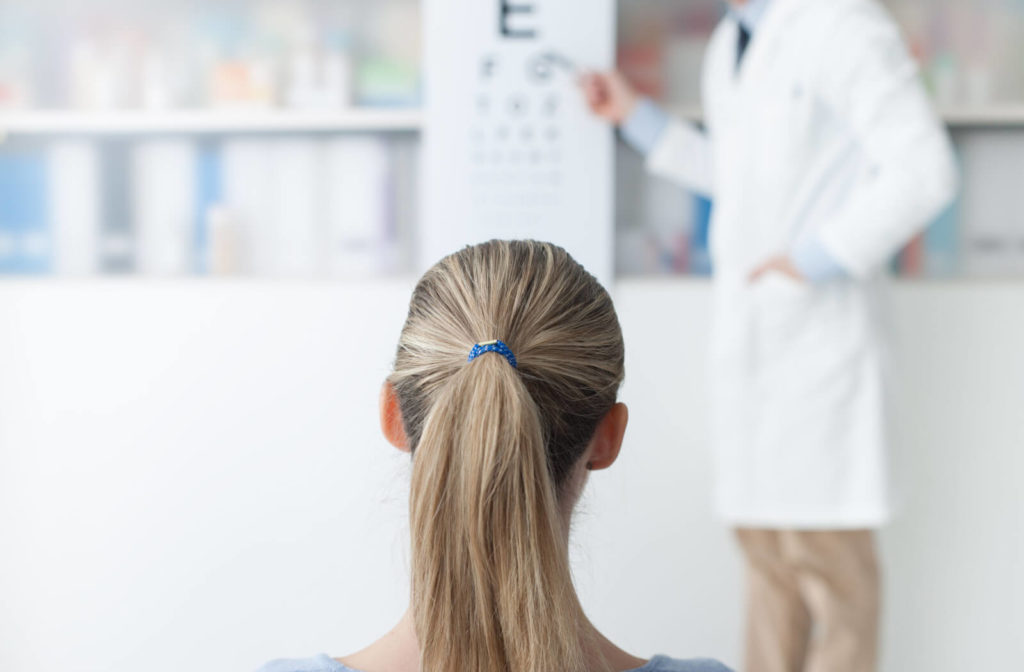Eye exams are as important as an annual checkup at the doctor. Scheduling an eye exam can help keep your vision clear and allow your optometrist to monitor your eyes for the signs and symptoms of eye conditions.
Maintaining an eye exam schedule doesn’t have to take too much time out of your day. Comprehensive eye exams last an average of 20–60 minutes. Making the time to have your eyes tested can be a critical preventative tool for your eye health and vision.
What Determines the Length of an Eye Exam?
Every eye exam is unique. Your eyes change from one appointment to the next, and your eye exam will reflect those conditions. Some factors that may influence the length of your eye exam include:
- A new eye injury
- If you have pre-existing conditions or are at risk of an eye disease that requires eye dilation as part of the eye exam
- If you’re experiencing vision changes or new symptoms that can indicate an eye condition
- If you present with risk factors for eye diseases
- If you’re a new patient and meeting your optometrist for the first time
Comprehensive eye exams are personalized to your eyes. We can provide an assessment of your eye health and vision and answer questions or concerns you may have while respecting your time.
What Happens During an Eye Exam?
During a thorough eye exam, your optometrist will perform a series of tests to assess the complete ocular structures and field of vision.
Visual Acuity
A visual acuity test assesses how well you can see from a distance. Your optometrist will use the standard Snellen chart of letters or symbols to help determine if your vision has changed.
During the test, you’ll sit or stand at a distance from the chart and use both eyes to read it out loud, down to the smallest letters you can see. Then you’ll repeat the same thing with only one eye, and do the same for the other eye. Your optometrist may perform rounds of this test with different combinations of lenses to determine your new prescription.
Refraction Assessment
Refractive errors occur when the shape of your eye distorts your vision in some way, and it’s becoming increasingly prevalent. The most common types of refractive errors include:
- Hyperopia (farsightedness)
- Myopia (nearsightedness)
- Astigmatism
- Presbyopia
When you have a refractive error, light enters through the cornea but can’t focus on the retina, causing blurry vision. Uncorrected blurry vision can lead to eye strain, headaches, or squinting. Refractive error tests can help determine which refractive errors distort your vision and find corrective lenses to restore clarity.
Retinal Exam
Optometrists use eye dilation and innovative technology to examine the structures at the back of the eye during a retinal exam. The non-invasive testing allows your optometrist clear views of the retina, macula, optic nerve, and blood vessels at the back of the eye.
A retinal exam can help optometrists detect eye health problems before they compromise your vision.
Intraocular Pressure
Tonometry tests intraocular pressure to find out if your eye pressure is in the normal range. High intraocular pressure can indicate fluid buildup in the eye and may suggest that the fluid isn’t draining properly.
Increased eye pressure can be a sign of glaucoma, so tonometry is a valuable diagnostic tool. If you have a family history of glaucoma, your optometrist may monitor your eye pressure to detect early warning signs.
Is a Contact Lens Exam Different Than an Eye Exam?
A contact lens exam should complement a comprehensive eye exam, but they’re not the same, so they’re not interchangeable. Contact lens exams have different aims than your annual eye exam.
If you’re new to contact lenses, your optometrist will take measurements and assess your eye’s shape and the surface of your eye to guide their recommendation for contact lens styles.
Your optometrist may ask how often you plan to wear your contact lenses. If they’re for sport and occasional wear, or you want to switch to contacts as your primary corrective lenses, they’ll review the choices of daily, bi-weekly, or monthly wear.
At your contact lens exam, your optometrist can reference notes from your most recent eye exam to identify concerns of dry eye, determine which lenses you’ll need for any refractive errors, and update your contact lens prescription.
Are Children’s Eye Exams Different Than Adult Eye Exams?
Your children should get their first eye exam earlier than you may think. Infants between 6–9 months can benefit from their first eye exam, and their exams are more straightforward than an adult’s. Optometrists examine the ocular structures and help ensure your children are on track to develop healthy eyes as they grow.
As your child grows into toddler and preschool years, their subsequent eye exam should be between the ages of 2 and 5. This exam will focus on overall eye health, eye focus, binocular vision, and tracking movements. Signs of lazy eye (amblyopia) and crossed eyes (strabismus) become apparent at this growth stage, and early intervention can help.
After the age of 5, children should have eye exams every year. Young children typically can’t communicate vision problems like adults, so watching their behaviour, in addition to frequent eye exams, can get your child the vision therapy or corrective lenses they need as they grow.
Book Your Family’s Next Eye Exams
For every family member, from adults to kids, eye exams can help maintain eye health. Whether you have a family history, worrying symptoms, or need a prescription update for sharper vision, a comprehensive eye exam is critical.
Contact us at River Heights Eye Care to schedule an eye exam or contact lens exam today.


